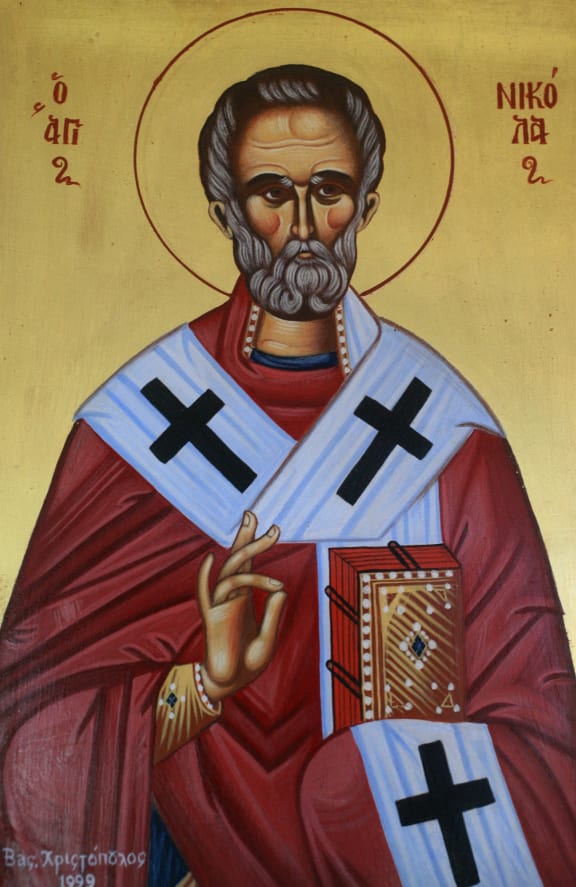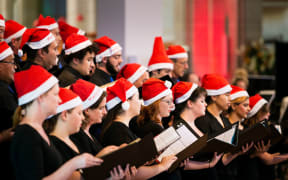
Everyone knows Santa Claus, but what about the Greek bishop who inspired him? Photo: 123rf
By Audrey Courty for the ABC
Yes, Santa Claus truly did exist.
The legend of a jolly red man who gives presents to children on Christmas Eve is based on the German and Dutch traditions of St Nicholas - a real-life bishop from ancient Greece.
He was known for secretly giving bags of gold to the needy, for offering bread and sacks of grain to the hungry, and for even rescuing three girls from a life of prostitution.
So how did St Nicholas become associated with Christmas and sleigh-riding across starry skies? Did he look anything like today's depictions of a plump, bearded man?
Sorting fact from fiction, here's what we found out about the real Santa Claus. But before you read on, we must warn you: we are not liable for dashing childhood dreams.
Was St Nicholas actually real?
Yes! We know from his remains and ancient texts that he was a real person.
But he lived far from the North Pole and was actually born in the eastern Mediterranean during the Roman Empire, nearly 2000 years ago.
According to historical records, St Nicholas was a Christian bishop in the ancient coastal city of Myra - what is now the modern-day city of Demre in southern Türkiye.
Dr Amelia Brown - a senior lecturer in Greek history and language at the University of Queensland (UQ) - has spent the last few years translating St Nicholas's biographical texts, which were written about a century after his death.
She says he served in the 4th century after Constantine the Great became the first Roman emperor to convert to Christianity and decriminalised the Church.
"Nicholas was known as a very charitable bishop. He was one that looked after his people very well," Dr Brown says.
She says he would leave coins and grain on people's windowsills or doorsteps, while also forcing merchants to sell bread and other staples at affordable prices.
During this time, bishops like him had charitable oversight of their cities and would hold church services and festivals, as well as officiate marriages and baptisms.
"They also had more and more responsibility for public works … so the bishops were in charge of repairing roads and fountains, and sometimes even helping with the defence of the city against pirates," Dr Brown says.
St Nicholas travelled widely across the Mediterranean region in his later years, before dying of old age in his 70s.
He was originally buried in Myra but his remains were stolen by merchant sailors in 1087 and taken to Bari, Italy, where they are now kept in a sarcophagus.
What did he look like and did he wear red?
Though St Nicholas likely had a beard for most of his life, he was not quite the ruddy-cheeked, blue-eyed character that we now see in storybooks and animations.
According to the most recent facial reconstruction by Liverpool John Moores University, he had dark brown eyes, an olive complexion and a broken nose.
The computer-generated image above, which was released in 2014, was based on all of the skeletal and historical material available.
"The broken nose suggests something about his character," forensic anthropologist Dr Caroline Wilkinson said in the early days of the project.
"He was considered a bit of a rebel - he may have come into conflict with people. He could have just fallen down some stairs, but it's quite a heavy-duty break."
UQ historian Dr Brown says it was common for bishops to have beards because they symbolised wisdom and holiness.
"He would have had a white beard for quite a bit of his life because he was quite elderly," she says.
As for his clothing, Dr Brown says there was no consistent dress code for bishops at the time but St Nicholas likely wore a red tunic once he became more prominent.
"The red does come later on in Italy when he is believed to be a cardinal in the Middle Ages, basically because he's a bishop and he's important," she says.
"But it isn't really until the 19th century and in America that he's portrayed wearing a red pants suit … These features appeared when his stories were adapted among the Dutch and the Germans."
So how did St Nicholas become widely known?
St Nicholas's generosity and gift-giving brought him renown, but it was thanks to his geographical position that word of his good deeds travelled far.

An icon of St. Nicholas. Photo: GODONG / PHOTONONSTOP / AFP
Dr Brown says his city of Myra was a significant juncture in the Roman Empire's communication network because it sat along major trade and shipping routes.
"The ways that certain saints were adopted more widely is not just because of their actual miracle stories, but also because they were taken up by sailors, by merchants, by travellers - and that was very important in spreading their renown," she says.
Dr Brown says he rose to prominence as the patron saint of children and youths, partly because one of his better-known tales involved three young sisters whose family couldn't afford their marriage dowries.
St Nicholas is said to have secretly given them the money so that the girls could marry and escape a life of prostitution. In one of the earliest depictions of this story, he is shown as dropping three bags of coins through the family home's window.
In other medieval paintings, the girls are shown as having hung their stockings to dry and the coins falling into them - this may be the origin of today's Christmas stocking-stuffing tradition, Dr Brown says.
What were some of St Nicholas's other stories?
Many of the stories about St Nicholas's interventions or "miracles" involved youths, as well as sailors and travellers.
Dr Brown says these stories were obviously embellished over time.
"In a prefiguring of Sweeney Todd, St Nicholas is said to have helped students avoid unscrupulous landladies who wanted to turn them into pies," she says.
"There's also some lyrical stories about him helping young men avoid trouble on the road and keeping sailors from drowning, getting them to where they needed to go."
In another often-cited tale, it is claimed he saved the lives of three Roman generals accused of misdeeds.
"Because St Nicholas knew that the generals were innocent, he appeared in a dream to the Emperor Constantine and told him not to execute them," Dr Brown says.
"Later on in Myra, those generals supposedly built a lot of beautiful shops and even helped build the first Church of St Nicholas."
That church still stands today and is preserved as a museum by Turkish authorities.
So how did today's Santa Claus legend come to be?
As word of St Nicholas carried into northern Europe, he inspired the Dutch legend of the jolly Christmas elf "Sinterklaas", and the German "Christkindle", which would then spread as far as the Americas through migrants.
Dr Brown says over time St Nicholas took on different forms and inspired various traditions around the world - reviving and reshaping the legend many times over.
"The Christmas tree, the 'tannenbaum', is definitely in origin a German tradition," she says.
"So it may very well be that there are aspects of Odin and other Norse and Celtic gods or heroes."
She says the modern-day story of Santa Claus climbing down chimneys to deliver gifts was likely the influence of a northern European tradition.
"It's definitely not a Mediterranean part of the story.
"It's always the windowsill or the doorstep, or somewhere private like that, so that he's not doing it in a public way and embarrassing them."
How St Nicholas became associated with 25 December is also not clear given he already had his own Christian festival.
"I was quite surprised about how he ended up getting attached to Christmas Day because he had his own gift-giving tradition, which was on his feast day of December 6," Dr Brown says.
One theory is that St Nicholas may have become conflated with one of the Three Wise Men or biblical Magi who came bearing gifts after Jesus's birth.
But it was ultimately an American poem written in 1823 that standardised the image of Santa Claus - the English pronunciation of "Sinterklaas" - as a "jolly old elf" riding a sleigh driven by eight reindeer on Christmas Eve.
The poem now known as The Night Before Christmas was widely popular and inspired a new era of Santa iconography.
Such is the way that a beloved gift-giver from ancient Greece became irretrievably wed to Christmas in the popular imagination.
* This story was first published by the ABC.




